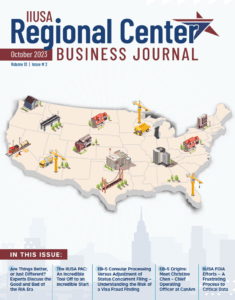
Regional Center Limbo: How Low Can You Go?
by Robert C. Divine, Vice President, IIUSA; Chairman of the Immigration Group of Baker, Donelson, Bearman, Caldwell, & Berkowitz, P.C.
Now that USCIS in its May 30, 2013 EB-5 Adjudications Policy Memorandum has recognized that (due to a 2002 law that trumps a 1991 regulation) a regional center application can be based on “general proposals” and does not always require “verifiable detail,” we have all wondered just how general the proposal can be and still be approved. In a recent non-precedent decision posted by USCIS on its web site, the USCIS Administrative Appeals Office has defined a low bar by affirming the denial of an application that stated that it had no actual or hypothetical projects and presented only a list of some companies in the region and their industries and submitted the RIMS II Handbook saying that it would “utilize third parties familiar” with RIMS II. The AAO stated:
While USCIS does not define the level of detail required for a general proposal, merely identifying the NAICS industry categories and the eventual input-output model without analyzing how the model would apply to a hypothetical project that falls under the industry categories is insufficient to meet the applicant’s burden within these proceedings. ..Simply submitting the RIMS II Handbook without any economic analysis as to how that tool might work in the industries identified does not meet the applicant’s burden of supporting its proposal with an economically or statistically valid tool.
On the issue of promotion of the regional economy, the AAO held that the assertion that the RC will maintain a web site and use the “rolodex contacts” of the RC’s managers is insufficient. The center director had found that submission of a “pro forma” Form I-924A was insufficient to show how the RC would fulfill its duties of administration, oversight and monitoring of investment activities under its sponsorship, but the AAO said that because it had other grounds on which to dismiss the appeal it would not decide whether 8 CFR 204.6(m)(6) (which addresses “Termination of participation of regional centers” for failure to submit annual reports or failur to keep promoting economic growth) requires any evidence in an initial RC application.
For those who have spent tens or hundreds of thousands of dollars on regional center applications including project development plans, this decision might be comforting-that still there are at least some actual requirements. But the AAO’s language suggests that a pretty bare bones hypothetical with a simple economic analysis might be sufficient to show that the applicant knows how to spot or organize a project that matches enough job creation with the minimum EB-5 capital planned for use with funds from other unspecified sources. The decision does not address whether third party validation of construction cost and timeline or third party market study validating an operational pro forma is necessary for an RC application based on a hypothetical project. The decision does not give hints about what showing is required to support a broad geography for RC approval.
The AAO also found that the application had made incorrect claims about the RC entity’s legal formation at the time of application and later and implied that this made it hard to believe anything else the applicant said. That part of the decision reminds us all to be careful and consistent with details in applications to USCIS.








